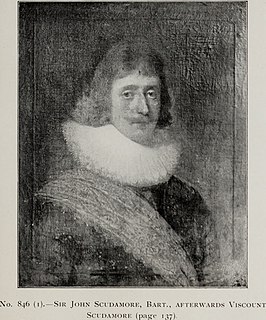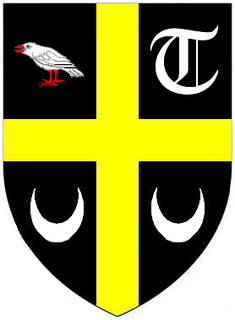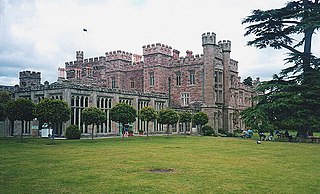
Earl Coningsby was a title in the Peerage of Great Britain. It was created in 1719 for Thomas Coningsby, 1st Baron Coningsby, with remainder to his eldest daughter, Margaret Newton, 1st Viscountess Coningsby, and the heirs male of her body. He was the great-grandson of the soldier and politician Sir Thomas Coningsby. Coningsby had already been created Baron Coningsby, of Clanbrassil, in the Peerage of Ireland in 1693, with normal remainder to heirs male, and Baron Coningsby in the Peerage of Great Britain in 1716, with similar remainder as for the earldom. On Lord Coningsby's death in 1729 he was succeeded in the Irish barony of 1692 by his grandson Richard Coningsby, the second Baron, the son of one of Coningsby's sons from his first marriage to Barbara Georges. However, Richard died already the same year, when the barony became extinct. Lord Coningsby was succeeded in the English barony and the earldom according to the special remainder by his daughter Margaret Newton, 1st Viscountess Coningsby. She had already in 1716 been made Baroness Coningsby, of Hampton Court in the County of Hereford, and Viscountess Coningsby in her own right. Both titles were in the Peerage of Great Britain. Lady Coningsby was the wife of Sir Michael Newton, 4th Baronet, of Barrs Court and Culverthorpe Hall, Lincolnshire. She had no surviving male issue and the titles became extinct on her death in 1759.
Henry Nevill, de facto 9th Baron Bergavenny was an English iron founder, soldier and politician who sat in the House of Commons at various times between 1601 and 1622 when he inherited the Baron Bergavenny peerage.
Sir Thomas Bowyer, 1st Baronet was an English politician who sat in the House of Commons at various times between 1614 and 1642. He supported the Royalist cause in the English Civil War.

Sir Thomas Coningsby was an English soldier and Member of Parliament, notable for his diary of military action in France in 1591.

John Scudamore, 1st Viscount Scudamore was an English diplomat and politician who sat in the House of Commons at various times between 1621 and 1629. In 1628 he was created Viscount Scudamore in the Irish peerage.
Sir John Pakington, 2nd Baronet of Westwood House, near Droitwich, Worcestershire was an English politician who sat in the House of Commons at various times between 1640 and 1679. He supported the Royalist cause in the English Civil War.
This is a list of Sheriffs and, since 1998, High Sheriffs of Herefordshire

Jonathan I Rashleigh, of Menabilly, near Fowey in Cornwall, was an English shipping-merchant, Member of Parliament for Fowey in 1614, 1621, 1625, April 1640 and November 1640, and 1661 and served as Sheriff of Cornwall in 1627. He supported the Royalist cause during the Civil War.

Sir Gervase Clifton, 1st Baronet, K.B. was an English politician who sat in the House of Commons at various times between 1614 and 1666. He supported the Royalist cause in the English Civil War. He was educated at St John's College, Cambridge.

James Scudamore was an English politician who sat in the House of Commons at various times between 1642 and 1668.
Sir William Russell, 1st Baronet, of Wytley, was an English politician who sat in the House of Commons in 1625. He was an officer in the Royalist army during the English Civil War and, as Governor of Worcester, he refused entry to the Parliamentary cavalry shortly before the Battle of Powick Bridge — the first cavalry skirmish of the Civil War.
Sir Henry Berkeley (1579–1667) was an English politician who sat in the House of Commons variously between 1626 and 1640. He supported the Royalist side in the English Civil War
Charles Price was a Welsh soldier and politician who sat in the House of Commons variously between 1621 and 1642. He fought on the Royalist side in the English Civil War and is believed to have been killed in a duel.

William Mallory of Studley Royal, Yorkshire was an English politician who sat in the House of Commons variously between 1614 and 1642. He supported the Royalist side in the English Civil War. His father, John Mallory, was also an MP of Ripon.

William Smallman of Kinnersley Castle, Herefordshire was an English politician who sat in the House of Commons in 1640.

Humphrey Coningsby was an English politician who sat in the House of Commons from 1641 to 1644. He supported the Royalist side in the English Civil War.
Sir Giles Brydges, 1st Baronet was an English politician who sat in the House of Commons at various times between 1621 and 1629.
Sir Henry Spiller was an English office-holder, landowner and politician who sat in the House of Commons between 1614 and 1629. He supported the Royalist cause in the English Civil War.
Sir Barnabas Scudamore (1609–1651) was a English military commander and active Royalist during the English Civil War. The son of James Scudamore and younger brother of Viscount Scudamore, he was from a prominent Herefordshire landowning family. His family's seat was at Holme Lacy.

The Siege of Hereford took place in 1645 during the English Civil War when the city of Hereford and its English Royalist garrison was besieged by a Scottish Covenanter army under the command of the Earl of Leven. The Covenanters were allied to the English Parliamentarian cause and moved to take the Royalist stronghold in the wake of their victory at the Battle of Naseby. After a month-long siege the approach of Royalist reinforcements and news of Montrose's victories against the Coventanters in Scotland forced Leven to abandon the siege and retreat. However in December of the same year the city was taken in a surprise attack by Colonel John Birch and remained in Parliamentarian hands for the remainder of the conflict.









